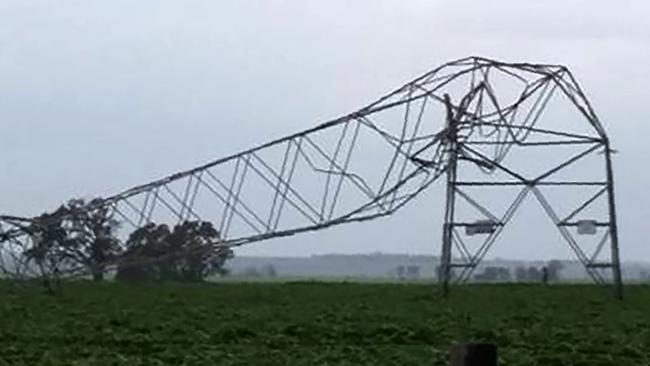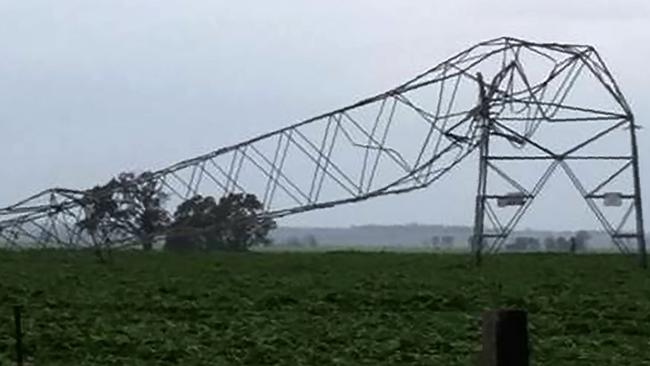AEMO’s third report highlights wind power link to South Australia blackout
A NEW report has shed more light on South Australia’s massive blackout and why wind power disconnected from the electricity network.

A NEW report has shed more light on how the blackout in South Australia occurred and why wind power disconnected from the electricity network.
The Australian Energy Market Operator (AEMO) released its third report today with its preliminary conclusions on the causes of the “Black System” that plunged the entire state into darkness at 4.18pm on September 28.
While tornadoes were found to have taken down three transmission lines ahead of the blackout, the report suggests the system could have continued operating.
Instead it was the loss of power from the state’s wind farms that is thought to be one of the primary causes of the event.
The AEMO said a protection feature built-in to some wind farms, which the agency was not aware of before the blackout, caused some of them to reduce their output after a certain number of voltage dips.
The reduction in wind farm output caused the system to get more electricity from Victoria through the Heywood Interconnector, but the demand was so high that it tripped a safety feature, cutting off supply to the state. This happened within 700 milliseconds.
While some wind farms and other electricity generators remained online and continued to function for a short time, the loss of supply from the interconnector and other wind farms caused the frequency drop to below 47 Hz and they were permitted to disconnect, leading to the blackout.
The AEMO has released 15 recommendations to improve the system and a final report is due to be published in March 2017.
WIND FARM OPERATION
The blackout highlighted that many wind farms have a protection feature which causes turbines to disconnect, stop operating or reduce their output if they experience more than a preset number of voltage dips within a two-minute period.
The AEMO said it was not aware of this protection feature before the SA blackout and this behaviour was not included in any stimulation models the wind farms submitted to AEMO.
Interestingly the AEMO said this type of fault has never been reported to the agency, and it was not aware of any reported instances of this phenomenon occurring internationally.
Wind farms are programmed to recover from voltage dips and some of the wind farms continued to operate and successfully rode through the faults.

But three of them disconnected or stopped producing power after their sixth voltage dip, ultimately leading to a drop in power generation from nine wind farms.
The AEMO will investigate why these three wind farms acted this way for its final report.
The number of voltage dips each wind farm is designed to withstand varies and AEMO is working with wind farm operators and manufacturers to review their settings.
Some of these settings have already been increased to provide extra capacity but AEMO noted improved limits would still be insufficient to avoid power drops among some wind farms if the September 28 events were repeated.
“Risks in this area still remain and will be assessed further in AEMO’s final report,” it said.
The loss of multiple wind farms has also been reclassified as a “credible” contingency event that is “reasonably possible” so that South Australia’s power system is operated with enough redundancy to withstand this type of action without breaching its limits.
It also noted about 20MW of wind power was disconnected due to excessive wind (typically more than 90km/h) in the last five minutes prior to the blackout but this was not a major contributor to the event.
RELATED: Preliminary report on the South Australian blackout released
WEATHER EVENTS
On the day of the blackout AEMO did a risk assessment at 8.30am when the maximum wind forecast was 120km/h and decided no action needed to be taken.
AEMO didn’t review this decision after an updated forecast at 12.57pm predicted winds of 140km/h (gusts) but post-event analysis found this would not have changed its actions anyway.
However, the AEMO has recommended this be changed so that reassessments are done.
The report also dismissed suggestions the blackout was caused by lightning strikes.
While there were 263 lightning strikes in five minutes in the Melrose region, the AEMO believes it’s unlikely they caused any of the five electrical faults and six voltage disturbances ahead of the blackout. This is because the lightning strikes looked to be cloud-to-cloud, not cloud-to-ground, in impacted areas.
But it does believe tornadoes that appeared near three transmission circuits between 4.05pm and 4.35pm at Brinkworth and Davenport, could be to blame.
“This information corroborates the conclusion that tornadoes were the cause of the five electrical faults that occurred before the system separation,” the report said.
It’s believed these tornadoes may have damaged the towers or conductors.

The Bureau of Meteorology reported wind strengths ranging from 190km to 260km/h in localised areas and evidence of tornadoes.
A fourth transmission line was damaged after the blackout but this has been blamed on severe winds.
But an AEMO analysis also found South Australia’s electricity system could have continued to operate despite the loss of four transmission lines due to storm damage.
“Based on AEMO’s initial static modelling, it seems likely the SA grid could have withstood the loss of all three power lines, and the fourth damaged after the Black System,” the report said.
RESTARTING THE SYSTEM
The AEMO reported that the restart ancillary service (SRAS) was unable to supply enough power to fully restart a major generating unit so the system was only started via the Heywood Interconnector.
By 8.30pm, about 40 per cent of the load in SA capable of being restored had been restored. This had grown to about 80 to 90 per cent by midnight. The remaining load was restored as transmission lines were repaired, with all load restored by October 11.
RECOMMENDATIONS
1. More rigorous processes be put in place to monitor weather warnings during extreme weather conditions, for changes in forecasts.
2. Develop better process for information exchange and reclassification decisions when faced with extreme wind speeds.
3. Assess risks on assets when wind speeds are forecast to exceed wind turbine over-speed cut-outs or rapid changes in wind direction.
4. Investigate developing a system protection scheme such as load shedding or generation tripping to avoid loss of connection with Heywood Interconnector.
5. Review allocation of load between under frequency load shedding blocks.
6. Investigate the feasibility of developing a system protection scheme to ensure a stable island within SA if the interconnector goes down.
7. Investigate the level of risk to power system security if power is lost from a concentration of wind farms, and develop measures to manage any material risk.
8. Review the system restart in detail to allow quicker identification of equipment that shouldn’t be used, speed the restoration of load, improve communication and other improvements.
9. Review the test plan against the actual system restart plan to identify differences.
10. Regular testing of the start of a low voltage generator alone.
11. Develop detailed procedures on the differences required in power system operations during periods of market suspension and any desirable rule changes.
12. Investigate whether a better approach could be taken for ensuring the minimum stable load of generating units is taken into account as part of the National Electricity Market dispatch process.
13. Review market processes and systems for changes to implement those improvements.
14. Develop a more structured process to source and capture data after a major event.
15. Investigate the possibility of introducing a process to synchronise all high speed recorders to a common time standard.



